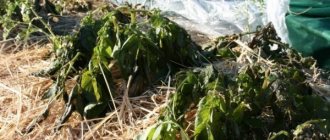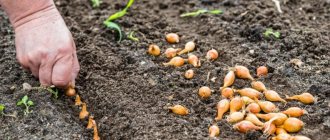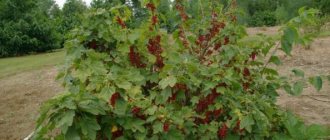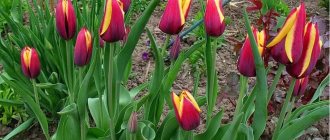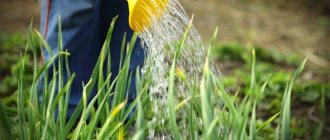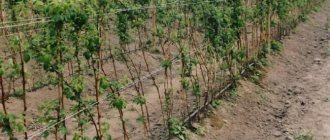Features of autumn planting
Experienced gardeners and gardeners have noticed that planting plants in soil that has warmed up over the summer in the autumn has a positive effect on their development. Many crops grow worse if they are planted in the spring, when the soil has not yet warmed up after winter. To achieve success when planting garden and vegetable plants, you need to consider the following:
- Look at the forecasts for what the next winter will be like. If it is expected to be harsh, choose only the strongest plants. In some cases, it is better to avoid autumn planting altogether, especially if you live in the northern regions.
- If there are a lot of rodents in the area, they can damage the roots and stems of plants. So get rid of the pests first.
- If the territory of the dacha community is not protected, you may lose everything that you planted on the site. Therefore, it is necessary to build a strong fence around the dacha so that thieves cannot enter the territory.
Perhaps for some, autumn planting seems like a difficult task. But in fact, if done correctly, you will get plants that are stronger than crops planted in the spring. During wintering they have time to gain strength. Therefore, plants planted in autumn are stronger and more resilient.
How to care for seedlings in spring
The first shoots of vegetables sown for winter appear when spring sowing is not even thought about. Of course, the weather conditions are still too harsh for the tiny plants, and they need additional care.
If you carried out your winter sowing in a greenhouse, then the seedlings may sprout very early, when the nights are still frosty and the sun is deceptive. Therefore, you will have to cover the seedlings with several layers of spunbond or take care of heating. If the crops were planted in open ridges, then as soon as the snow melts, place arcs over them and stretch the film or other dense covering material. This will bring the harvest closer to maturity by another 7-14 days.
The main problem for seedlings is most often the dense crust of earth compacted over the winter, which does not allow the sprouts to break through to the sun. That is why, after the snow melts, you need to carefully loosen the planting areas, breaking the crust if it has formed.
Further care comes down to weeding, watering and timely processing, depending on what you planted in the fall before winter.
Pre-winter planting of vegetables will not free you from sowing in the spring, because not all vegetables survive wintering in open ground. However, an early harvest of winter-hardy crops will save you a lot of time and money, because you, unlike your neighbors, will not have to go to the market for your first vitamins.
Trees
Autumn is a great time to replant garden trees or plant new seedlings. Typically, such work is planned for September or early October. Sustained frosts should begin no earlier than in a month.
You need to plant trees that grow well in your climate zone. They should tolerate cold well. Therefore, avoid planting trees that grow in warm climates. For example, you should not plant cherries, peaches, apricots, walnuts or chestnuts in the fall.
If you want to plant fruit trees, give preference to apple, pear, and some varieties of plum. Mulberries and rowan berries are also planted in the fall.
Coniferous trees are planted before winter:
- spruce;
- thuja;
- fir;
- pine
You can also choose hardwood:
- linden;
- poplar;
- alder;
- maple;
- willow;
- ash.
Gardeners do not recommend planting oak and birch in the fall due to the characteristics of their root system.
When choosing seedlings, pay attention to their appearance. The trees must be healthy, there should be no defects on the roots and branches. They are planted together with a lump of earth. After installing the seedling in the prepared hole, it is watered. If the autumn is rainy, subsequent watering is not necessary.
What to plant in a dacha garden in open ground in the Moscow region
If you're interested in gardening, don't forget about gardening. Experienced gardeners renew the garden in the fall and plant fruit trees. For autumn planting, buy seedlings of apple, pear, plum, and cherry trees with a closed root system (with a ball of earth). Small trees require 2-3 weeks of warmth to establish. Taking into account the climate in the Moscow region, they are planted in September. Don't forget to feed the plants with mineral and organic fertilizers. This will strengthen them before the long winter.
It's time to plant shrubs in your dacha in September: gooseberries, raspberries, black and red currants. With proper care, they will reward you with a harvest of berries already in the second year of life, and you will delight your loved ones with preserves, jams, and compotes. After planting, currant bushes are pruned short so that the plant is properly formed. If there is a lot of free space at the dacha, decorate the area with picturesque alleys or hedges - plant rose hips, hawthorn, viburnum, rowan. These shrubs are beautiful at different times of the year: both during the flowering period and during the harvest period. Their fruits are pleasant to taste and healthy; they are useful both for medicinal purposes and as a dessert.
Shrubs
Autumn is a good time for planting shrubs. Already in summer it will be possible to harvest the first harvest of berries. For example, you can plant currants (red, black or white), honeysuckle, barberry or gooseberries.
The bush can be used as a hedge. Rosehip, hawthorn, and juniper are suitable for these purposes. And the berries of these plants can be used to prepare various medicines.
Ornamental types of shrubs are also planted in autumn. The most popular types of this group are:
- spirea;
- boxwood;
- mock orange;
- privet;
- holly;
- beslet;
- snowberry.
If you like flowering shrubs, you can plant lilac, bird cherry or jasmine on your site.
Vegetables
Many garden crops are grown in the fall. The first shoots will appear in spring, when the weather is favorable for the active growth of vegetables and herbs. It is recommended to abandon sowing altogether if there is no snow on the ground on the site or there is heavy rainfall during the cold period.
Winter crops germinate well if the autumn has been long. The temperature should not fall below -3°C. In some regions, you can plant vegetables even in December. But it’s better not to risk it and do this work in the fall.
The beds must be prepared in advance, because the ground can become very hard. It is difficult to process it during the cold period. Once you have completed the summer harvest, dig up the soil. Remove weeds from it. Add nutrients as necessary according to the type of crops you will grow here. The soil should be leveled, without large clods.
Dig furrows in the beds in advance. Dry soil is also prepared in advance. It is poured into bags or buckets and left in the house or barn. Here it will be soft and will not freeze. During planting, the seeds are simply distributed in prepared holes or grooves, and then they are covered with soil prepared in advance. Next, the beds are covered with a layer of dry leaves or straw.
Tips for gardeners and gardeners
It is very important to choose the right time for planting and not to rush. If you sow crops too early, there is a high probability that seedlings will not even appear in the spring. It is important that the seeds swell in moist soil, but do not have time to germinate. Most plants need to be planted in frozen ground, but it is better to prepare the beds in advance so as not to poke around in the frozen ground. Late summer and early autumn are good times for this. There should be no large lumps in the beds, the soil should be loose. The seeds are covered on top with a layer of earth or peat, which should not be frozen, so the top layer must be kept in a warm place or use store-bought mixtures.
Garlic
Large teeth are suitable as planting material. They should not have any defects. Only large cloves can produce large heads of garlic. They are planted a month and a half before the onset of stable cold weather.
You need to separate all the teeth from the head immediately before planting, not earlier. The bottom needs to be removed. Otherwise, it will prevent the plant from sprouting roots. The teeth are planted to a depth of about 50 mm. There is a distance of 200 mm between the rows. The beds are covered with a 40 mm layer of peat, which is removed in the spring.
Onion
You need to buy a set that is 10 mm in diameter. It does not form powerful arrows. This is an advantage if only the bulb is needed. The plant does not waste energy on small shoots. The bulb will ripen in mid-summer. Sevok is planted in the last ten days of September.
If you need greens, choose large onions. Their diameter is 30 mm. The vegetable is planted 14-15 days before stable frosts. The roots will have time to adapt to the soil, but the plant’s shoots will not begin to grow yet. The bulbs are planted to a depth of 40 mm without watering. The beds are covered with humus with a layer of 100 mm. In early spring the cover is removed.
Carrot
Carrots are planted in the beds half a month before frost. It is important to guess the weather so that the seeds do not grow and die due to extreme cold. Usually, after the first frost, the seeds are added to the soil. The soil will already be dry by this time. Experienced gardeners adhere to the guideline of +3°C. When this temperature becomes stable, you can sow carrots. Seed consumption should be 20% more. This allows you to cover winter losses.
The seeds are located at a distance of 20 mm from each other. They are deepened by 25 mm.
Radish
This crop is often sown in the fall. Seeds are added to the soil in early November. The harvest can be harvested as early as mid-April. Approximately, you need to plant radish seeds in the ground at a temperature of about +1°C. If there is a thaw, they will germinate and die. Therefore, it is better not to rush into sowing.
There is a distance of about 30 mm between seeds, and 100 mm between rows. The depth of the holes is 30 mm. The beds are covered with a layer of sawdust or peat 35 mm. In the spring, until the snow begins to melt, the crops are covered with film.
What to plant before winter in the Moscow region in the garden?
Inexperienced summer residents often ask themselves this question. But let’s stumble a little - not all crops can survive winter. This is due to low temperatures, thaws and subsequent frosts.
Excellent for sowing are onions for greens, carrots and beets, garlic, parsley and dill, radishes. There are some autumn varieties of flowers that are suitable for wintering and young trees and shrubs.
Why is it worth planting certain types of vegetables, flowers, etc. in the fall? There are reasons for this:
- Overwintering the seeds will provide resistance to pests and diseases. In turn, the seeds are protected from spring pests when they are dormant during growth.
- Compared to spring planting, the harvest is harvested 3-4 weeks earlier.
- Resistance to spring dryness. The seeds are protected from such cases by water that is formed when the snow melts.
Trees, shrubs and flowers suitable for wintering adapt to the climate of a given area and become resistant to pests and diseases.
Planting flowers
In the fall, you can start designing a flower garden. Having chosen a suitable place for planting, you need to dig up the soil here. It is loosened and leveled with a rake. Use the edge of a hoe to mark the pattern of the flowerbed. The lines must be clear and deep, otherwise the seeds will be washed away by heavy rains.
Then you need to draw the beds for future crops. Their depth should be 2 times greater than usual. During the winter the soil sags and cakes.
Using slate, polycarbonate or other suitable materials, the bed is divided into separate sections. A separate sign is stuck into each of them with the name of the flowers that you plan to grow here. The beds are left until stable frosts are established.
It is necessary to prepare the soil for future planting of flowers in early October, when dry weather sets in. There should be a stable above-zero temperature outside. It is necessary to prepare the substrate for filling the holes. While the soil is soft, one part of it is mixed with 2 parts of peat and 1 part of sand. The mixture is stored indoors.
When stable sub-zero temperatures arrive, you can begin planting. There should be no thaws for at least the next half month. Seeds are sown 2 times thicker than in the spring. They are poured into frozen holes, covered with the prepared substrate.
Varieties of vegetables for winter. We are waiting for frost. What vegetables and herbs should be planted before winter for an early harvest?
At the end of October - mid-November, while the snow has not yet covered the ground, experienced gardeners plant vegetables and herbs. Pre-winter sowing allows you to harvest in late spring, when the body is so lacking in vitamins, and the reserves from the cellar have already run out.
What to sow before winter
Not all seeds can survive severe frosts in the ground. Carrots and beets easily survive among vegetables. The fruits of early carrots are juicier, sweeter and larger than ordinary ones. The secret is that it grows in early spring, when the soil is very moist. You can also plant radishes, turnips and peas. The most popular greens are garlic and onion sets. Even without any fear, gardeners plant sorrel, dill, parsley, celery, parsnips, lettuce and spinach, Chinese cabbage and leeks before winter.
“Sowing before winter should not be too large. The crops will ripen in late May - early June, but they will have to be eaten promptly in early summer. They will not be able to be stored for a long time, notes agronomist from Chelyabinsk Lyudmila Pashnina. “By the way, in anticipation of winter, annual flowers such as casmea, calendula, aster, aquilegia, chamomile and celandine are also planted.”
Make it before the snowfall
You need to prepare the beds and soil for winter sowing now. But it’s too early to sow seeds, because the thermometer during the day rises to +10 degrees. Due to the heat, the plants will begin to sprout and die with the first frost.
“Seeds should be sown only during stable frosts, when the soil temperature drops to -5 degrees. That is, the rainy season should already be over, and snow is about to start. At this time, the ground will already freeze and even crust over a little,” notes the Chelyabinsk agronomist.
Making the right furrows
The soil should not contain moisture, so it must be prepared in advance and stored in a dry, dark place. To do this, mix soil with sand, or take humus. Fresh manure is absolutely not suitable in this case.
It is advisable to place beds for winter crops from north to south. The snow will melt off them faster, and the crops will not shade each other in sunny weather. A place for planting in the garden must be selected with loose and more fertile soil. The best option is where green manure grows between the rows. They are a source of food for microorganisms, which will help crops germinate when spring comes.
Carrots, beets and greens should be planted in furrows made in the bed at a depth of 1 - 2 cm, and not on ridges. Otherwise, melt water will wash away the seeds.
“We sow the seeds in furrows at a distance of 15–20 cm. We also add drunk tea there, that is, tea leaves that have already been used, or coffee grounds. It is important that this organic matter is dry. With its help, fewer weeds will come out of the ground, advises Lyudmila Pashnina. – Sprinkle the furrows with pre-prepared dry soil, and then lightly tap them with your hand. The seed must be firmly in the soil, since air voids will not allow it to germinate quickly in the spring.”
Little secrets of a big harvest
Under no circumstances should you water vegetables and herbs planted before winter. Otherwise they will freeze. But on top you need to put a special covering material or dry grass.
Onions, garlic and herbs are planted according to the same principle as carrots and beets. The grooves for garlic can be made with an ordinary stick; the depth of the hole should be no more than 6 cm. This way, the garlic will not be able to cut through ahead of time. We also cover the top with mulch.
“The larger the clove planted, the larger the head of garlic will subsequently be. But with onions the opposite rule applies. The fewer sets, the better the onions will grow,” says an agronomist from Chelyabinsk.
